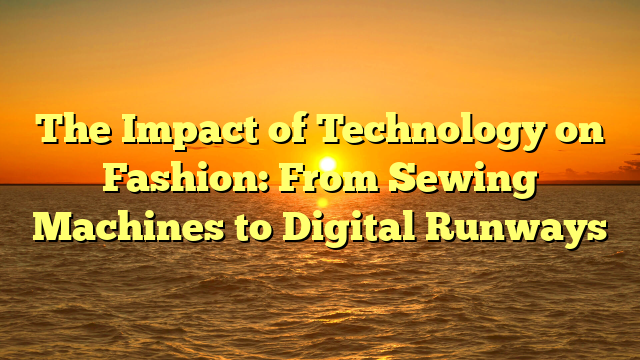
Technology has always been a driving force behind the evolution of fashion. From the invention of the sewing machine in the 19th century to the rise of digital fashion in the 21st, advancements in technology have transformed how clothing is designed, produced, and marketed. This intersection of innovation and creativity continues to shape the industry in unprecedented ways.
angsa4d sewing machine, invented in the mid-1800s, revolutionized garment production. Before its invention, clothing was handmade, a time-consuming and labor-intensive process. With the sewing machine, garments could be produced faster and more efficiently, enabling mass production and making fashion accessible to a broader audience. This innovation laid the foundation for the modern fashion industry, introducing ready-to-wear collections that catered to various socio-economic groups.
In the 20th century, synthetic fabrics like nylon, polyester, and spandex emerged, further altering the fashion landscape. These materials, developed through advancements in chemical engineering, allowed for greater durability, flexibility, and affordability. Designers could experiment with new textures and forms, resulting in clothing that was not only stylish but also functional. Sportswear and athleisure, now staples in modern wardrobes, owe their existence to these technological breakthroughs.
The digital age has brought another wave of transformation. Computer-Aided Design (CAD) software has become an essential tool for designers, enabling them to visualize and refine their creations with precision. This technology reduces waste by allowing adjustments to be made digitally rather than through physical prototypes. Additionally, 3D printing has opened doors for highly customizable and sustainable fashion, where entire garments can be produced with minimal material waste.
Technology has also streamlined the production process. Automation in textile manufacturing, such as robotic cutting and sewing, has increased efficiency and reduced costs. Moreover, innovations like smart textiles have blurred the line between fashion and technology. From temperature-regulating fabrics to garments embedded with sensors that track health metrics, wearable technology is pushing the boundaries of what clothing can do.
Marketing and retail have been equally transformed by technological advancements. The rise of e-commerce platforms like ASOS, Farfetch, and Amazon has made fashion more accessible than ever. Social media platforms, particularly Instagram, TikTok, and Pinterest, have become powerful tools for brands to engage directly with consumers. Influencer marketing and targeted ads leverage algorithms to personalize shopping experiences, creating a seamless blend of technology and consumer engagement.
The advent of augmented reality (AR) and virtual reality (VR) has introduced new possibilities for digital fashion. Virtual try-on experiences allow consumers to see how clothes will look and fit without leaving their homes. Digital fashion shows, such as those pioneered during the COVID-19 pandemic, have provided innovative ways for designers to showcase their collections globally. Platforms like The Fabricant and DressX even allow consumers to purchase and wear entirely digital outfits for online interactions, highlighting the growing influence of the metaverse on fashion.
As technology continues to evolve, the fashion industry is poised for even greater innovation. From AI-driven design processes to blockchain-based supply chain transparency, the integration of technology is reshaping every facet of the industry. What began with the humble sewing machine has now expanded to digital runways, proving that technology is not just a tool for fashion—it is its future.





